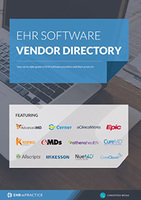3 EHR trends to watch for in 2016
Predicting trends in any market can be an imprecise art, particularly when making a prediction as to which technology will move from the fringe to mainstream or what technology will disrupt industry standards. Unfortunately, often the art of predicting trends is subject to inflated expectations in which new technologies receive the publicity that often oversell its actual value or functional ability.
Predicting trends in EHR
Predicting EHR trends adheres to this as it is complicated by inflated expectations, as policy makers and other stakeholders in the healthcare community often seek out that technological ‘magic bullets’ that will improve the quality of healthcare while reducing the cost of these services. For years, these have been cloud computing, big data analytics and telehealth, these technologies are significant in the healthcare space; however due to the slow pace of healthcare technology adoption the full promise of these technologies have not been realized. Thus, one is left to wonder, will the next big thing in EHR come as spin offs from those ‘magic bullets’ named above, or will it come in the form of something new.
One method of determining what direction innovation in EHR is heading involves following the money. Given that the development of innovative EHR technology depends mainly on investment, one can use patterns of venture capital investment as a proxy for emerging areas in EHR technology.
Mercom Capital Group, a global communications and research firm, tracks investment funding patterns in the healthcare information technology shows that among all health care practice-centric companies raised $2.4 billion in 234 deals for 2014. These investments included clinical decision support companies with $517 million, followed by data analytics companies with $367 million and population health management companies with $247 million. Further, these data show that mobile health companies were the largest recipient of venture capital investment at $1.2 billion with a going to wearables and mHealth apps.
Recommended Reading: EHR Vendor Guide - Find the right EHR vendor for your practice.
Given these investment trends, what developments in the EHR space can we expect to gain traction in 2016?
1. EHRs that can offer integrated data collection and management into population health management efforts.
The functions that may be included in into population health management or population health analytics in the future include a number of more sophisticated predictive modelling tools and real-time analytic capabilities.
For example, advanced analytics has been proposed to model the prospective economic cost of illness such as in the case of advanced financial analytics:
2. Patient centric EHR platforms
Given the growing shift toward emphasis on quality-based reimbursement and patient engagement as part of the Meaningful Use Stage 3 criteria, it should not come as a shock that patient-centric platforms would are evolving to become an integral component of the EHR. Although it is not likely to be an area whereby a disruptive technology emerges the run of the mill patient engagement method of the patient portal will likely receive a major upgrade in 2016 and beyond whereby patients can be more meaningfully engaged in their care beside just reviewing their records, appointments and billing online.
3. A practical link between wearables and treatment
Patient-generated data collected by mHealth devices will become a significant part of the to the clinical record allowing insights into wellness and fitness Ryan Beckland, Validic co-founder and CEO, in an interview with mHealth News states. "Access to digital health data provides physicians, nurses, clinicians and teams with deep and verifiable insights that really cannot be gained, or necessarily trusted, from manual-entry by a patient. It makes sense for healthcare providers, as well as health IT vendors, that data integration is the next step."
If one were to ask what the future of EHR will look like at the end of 2016 it will likely look like the present, with the most significant difference being that a wealth of companies in these areas noted above will be advancing their products to market with some of the areas becoming viable markets as practices warm up to their value.
Free white paper

EHR Vendor Directory
Get the most up-to-date directory of EHR software vendors. Find the best software for your practice.

Featured white papers
Related articles
-

Top ophthalmology EHRs for your selection shortlist
Got your eye on a new ophthalmology EHR? Here are some top contenders.
-

Allscripts acquires Practice Fusion: what this means for users
What effect will Allscripts' Practice Fusion acquisition have on the EHR market
-

Three 2018 digital health predictions from a physician and CMO
Expert advice on what to expect in the digital health sphere for the coming year



